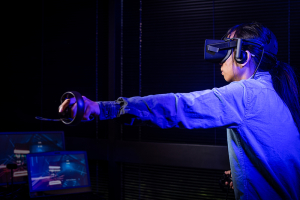NSF Grant Funds Collaborative Research Involving Three Universities
Virtual and augmented reality (VR/AR), once only existing in the realm of science fiction, are now a growing part of our daily lives. If you have ever used Snapchat face filters or played Pokémon GO, you have used AR technology right from your smartphone. The gaming industry pioneered the use of virtual reality technology for end users decades ago, and now many law enforcement organizations are using VR technology for training.
“Driven by the significant performance improvement of computing hardware and the revolution of graphics and display technologies, virtual reality (VR) and augmented reality (AR), which were invented back in 1990s, are now experiencing rapid growth and debuting into mainstream markets,” said Xin Fu, associate professor of electrical and computer engineering at the UH Cullen College of Engineering.
“Both VR and AR are increasingly being adopted in smartphone apps for providing rich experience to mobile users,” she said.
Retailers across a number of industries have noticed and are using VR/AR technologies to engage and enhance their customer experience. This has led to some convenient and innovative applications – such as virtual fitting rooms where customers can see images of themselves in different outfits and skip all the hassle of actually trying outfit after outfit as well as apps that allow customers to see how products, such a piece of furniture or decorative element, will look in the setting of their homes before purchase.
Mobile AR, which already has access to over a billion smartphone users, is expected to generate $3.4 billion by the end of 2019 and $9.6 billion by 2020, according to SuperData, a Nielsen company.
However, the limits of computing hardware in mobile devices make them hardly able to support the tremendous resource requirements by VR/AR and satisfy user demands for more seamless experiences.
The National Science Foundation awarded three universities a $450,000 grant to work on a project titled “Enhancing Mobile VR/AR User Experience: An integrated Architecture-System Approach.” The institutions involved are: the University of Florida as the lead, the University of Houston and Western New England University.
“Response time, battery life, and thermal challenges are the major obstacles to enabling the resource-intensive mobile VR/AR applications on compute, memory, and power-limited mobile devices,” said Fu, who is the UH principal investigator on the project. “The proposed research, which leverages the unique features of VR/AR to holistically and cooperatively tackle these challenges with integrated architecture and system support, will open the door for next generation mobile platforms that provide high-quality low-power VR/AR services to satisfy numerous mobile users.”
The collaborative project has four objectives:
• Approximate computing to eliminate unnecessary workloads in mobile AR/VR to achieve benefits on performance, power and thermal issues without sacrificing image quality and output accuracy.
• Emerging technologies enabled mobile VR/AR for performance/power optimization.
• Exploiting dynamic thermal energy harvesting to cool hotspots, prolong battery life and improve performance.
• Integration of the key research innovations and cross-technology optimizations to maximize the performance, power and thermal enhancements.
Fu’s collaborators are Tao Li from the University of Florida and Amer Qouneh from Western New England University.
The results of the research could impact VR/AR products and applications in a great number of fields, including education, medical and entertainment, Fu said.
“If successful, the proposed research will enable mobile devices to meet the increasing demands for excellent VR/AR user experience,” she added. “It will also satisfy the desire for launching more innovative VR/AR applications into the mobile device market, making everyday living and working more convenient and efficient.”

